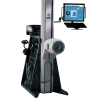
Enhance Your Physical Therapy Practice Through Data-Driven Client Assessments
Treatment GuidelinesIn accordance with the “triple aim” of the Patient Protection and Affordable Care Act, healthcare providers are now held to a higher level of accountability than ever before. Therapists must demonstrate measurable results and an enhanced patient experience. This process begins with an accurate assessment of the client’s physical therapy needs.
Innovations in technology have altered virtually every aspect of our lives. From mobile devices to industry-specific software, we’re now able to access real-time data with just the click of a button. For the healthcare industry, this has led to greater collaboration amongst physicians, rehabilitation practitioners, and researchers, all by utilizing electronic health record data to design a system of best practices.
Access to such an abundance of data has proven to be a double-edged sword, though. It’s necessary for insurance reimbursement as well as designing quality treatment strategies. Synthesizing disparate data, however, can prove a daunting task. Fortunately, practitioners now have access to interactive assessment systems, which allow for more streamlined patient evaluations. These tools gather and analyze patient data, delivering predictive analytics which help determine the precise type and amount of care needed for long-term success. Processes are streamlined and inconsistencies are reduced, providing therapists greater opportunities to deliver quality client assessments at lower costs.
Less Waste and Greater Care Through a Precise Treatment Plan
In accordance with the “triple aim” of the Patient Protection and Affordable Care Act, healthcare providers are now held to a higher level of accountability than ever before. Therapists must demonstrate measurable results and an enhanced patient experience. This process begins with an accurate assessment of the client’s physical therapy needs. Through actionable data, the therapist is able to develop a timeline of care, providing the patient and insurance carrier with an accurate assessment of the functional change expected, upon discharge. Therapists are able to develop a creative strategy that inspires the patient to be actively involved in their recovery. Goals are achieved methodically and swiftly, thus bolstering the bottom line, improving patient care and optimizing productivity. In the end, all parties involved receive a better and more cost effective outcome.
Using Data to Prescribe Preventive Care
Historically, physical therapy was primarily prescribed to reduce recovery time, post-surgery, ensuring the patient’s body realigned itself to proper positioning. With the help of technology, healthcare professionals are now able to convey to insurance carriers the value of preventive maintenance. Therapists can evaluate a patient’s range of motion, muscle performance, flexibility, and movement patterns. Analysis of this data assists in identifying the underlying issues, moving preventive maintenance to the forefront, with surgery as a last resort. At a time when we’re all encouraged to reduce costs without sacrificing care, preventive maintenance strategies could help us realize significant cost savings.
Over the last decade, there has been a shift in how healthcare is valued. Patient-centric care is goal number one, with the realization that everything else falls into place when their needs are met. Insurance companies and healthcare professionals are working together to ensure a positive and efficient experience. Through the use of interactive assessment systems and wearable technology, physicians are able to design a treatment plan that benefits everyone. Insurance costs are reduced, allowing carriers to pass that savings on to their customers. Patients are on their feet and back to work in less time. Productivity rises, absenteeism is reduced, and reoccurring injuries are prevented. In essence, your data-driven assessment goes to work for everyone.
Sources:
http://www.apta.org/PTinMotion/2015/6/Feature/PowerofPrediction/
http://www.apta.org/PTinMotion/2016/9/Feature/InternetOfThings/




